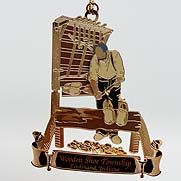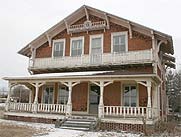2010 Essays: Honorable Mention— The Horrors of Adolf Hitler: A Firsthand Experience of a Childhood Filled with Terror by Darianne Cherry
He loved innocent children and those adults who supported him—in his eyes real Germans. —Frank E. Smitha Adolf Hitler worked for ten years to gain total control in Germany; his push to the top did not come easily. In January of 1933, Hitler’s struggle came to an end. (Smitha 1) The children, adults, and Jewish people of Germany had no idea their lives would soon be turned into the unimaginable. Marta Kloeck, now a Ferdinand resident, witnessed and survived Hitler’s terror.
When Hitler came to power, the Jewish people made up only one percent of the German population of 55 million people (Philip 1). Unfortunately, the killing of not only the Jews, but also many other helpless citizens, began shortly after Hitler came to power. This panic did not end until Hitler’s Nazi soldiers became forbidden in 1945. (Holocaust 1) Marta, only eight years old at the time of Hitler’s reign, experienced the pain and challenges of living a different lifestyle at a young age. Marta lived in West Germany close to Heilbronn. She grew up in a two-story brick house in a small town about the size of Ferdinand—the larger city about a mile away. The fourth oldest child of the family, Marta had five sisters and three brothers. Because her family was not Jewish, she did not experience the Nazi violence physically. Unfortunately, she saw and heard the horror. Living in a wealthy household became a great advantage to Marta and her family. Her father worked in a chemical factory; this kept the family from suffering like many other starved Germans. Marta also remembers her father buying food from the black market. Of course, this could have led him to unthinkable trouble if caught, but “being careful” under Hitler’s control became a lesson children, not only adults, learned. (Kloeck 1)
Before learning about the appalling acts Hitler would commit, Adolf seemed like a common, ordinary man to govern the German people. Similar to many leaders, he wanted to strengthen Germany. Hitler helped the unemployed and gave food to the poor. He also found support from most social classes. Although some agreed with his tactics, many people disagreed with his anti-Semitism beliefs. (Smitha 2) Hitler told people that the Jews were the “racial opposite” from the Germans. He assumed the Jewish took part in some plan to stop the German race from taking their position as becoming “rulers of the world.” (Philip 1) Although not one Jewish person owned a company or industry in Germany at that time, Hitler still attacked them (Smitha 2). Hitler’s segregation rules sprang up quickly after taking control. Jews couldn’t marry non-Jews or even sit on the same bench as a non-Jewish German (Philip 1).
Taken out of public schools, Jewish children did not receive educations (Philip 1). After Hitler came to power, all children had to wear uniforms to school. According to Marta, “It didn’t matter if you were Jewish or not. You had to obey his rules or you would be shot in the street.” (1) The most important aspect to Hitler was his power of education. With Germany under Hitler’s command, textbooks changed to follow his Nazi ideas. This especially went for history books—many held lies. Books greatly emphasized the French and Jewish, the country’s enemies. Teachers and professors agreed to teach Nazism but never religion. (Elliot 63)
Hitler made sure to teach his anti-Semitic viewpoints and Nazi ideas to the adolescents; he did this by forming youth groups. The Nazis took over the youth groups in June of 1933. Baldur van Shirach then controlled them. Seven and three-fourths of a million children belonged to a youth group in 1938. Boys participated in many organizations between the ages of six and eighteen. In camps, the boys were taught Nazi ideas, various sports, and camping. After this practice, they spent their last four years in the Hitler Youth where they prepared for military service to become a Nazi soldier. Not as important as boys in Hitler’s eyes, girls worked in factories and farms. Although some joined The League of German Maidens, he supposed most girls should marry and eventually have families that would become part of the Nazi army. (Elliot 62-63)
Firm and sturdy described Marta’s personality as a child when around a Nazi or SS soldier. Even non-Jewish children had to watch what they said. (Kloeck 1) The SS had no sympathy; children had to speak the correct responses because they knew the consequences. Marta continued: “If you made one mistake, you were taken away to a concentration camp. The Nazis took any child who misbehaved.” Many Germans believed Hitler alone seemed more considerate than his Nazi soldiers who killed anyone without a care. (Kloeck 1) Marta’s family did everything they could to help protect the Jewish people. Her father built a wooden wall in the cellar for Jews to hide behind and live until they felt safe. Strangers sometimes stayed in her house for two or three months at a time. Marta’s parents never told the children about the Jewish people living with them for fear that they would accidentally slip the truth to the Nazi soldiers. Although Marta never knew for sure, she knew when her mother kept more food in the house than what the family alone could eat. Piles of extra dishes also gave Marta hints that her parents kept secrets about the hidden Jews. SS soldiers came to her house once a month to make sure the family followed Hitler’s regulations. Adolf demanded that all families kept photos of him in their houses. If the family did not follow this rule, they would be considered outcasts. Marta’s mother kept pictures of Hitler behind the family frames. When Nazis checked the house, she would quickly slip Hitler’s photograph in front. According to Marta, now 85 years old, “You could expect anything when the SS came. They tortured kids for the truth.” The Nazis brought guns in the house and asked children many questions; they had no respect. Marta’s family held meetings in the evenings before Nazi visits. Told what they could and could not say, Marta and her siblings had to act cautiously and maturely. (Kloeck 1)
At only eight, Marta recalls seeing Jewish people forced into trucks and taken to gas chambers and concentration camps. Along with friends from school, she hid while watching the Nazis line up powerless Jewish children and adults around a large hole in the ground. The sight of these vulnerable people shot in the back and falling into the pit still haunts her today. (Kloeck 1) Living next to one of the largest concentration camps, Auschwitz, Marta saw many horrifying displays as a child. Many Jewish children died before even making it to a concentration camp because of the atrocious heat and cramped conditions. The SS made new arrivals at camps sign postcards to their families back home. Postcards stated that their Jewish relatives came to a false location called “Waldsee” and “all was well.” (Philip 4) At camps, men and women, along with children, had to have their hair completely shaved. Forced to cram inside an area that looked like a massive shower, carbon monoxide filled the air. Jewish people died by the thousands. Gas chambers were just one method of killing the Jews. Sadly, children shorter and closer to the floor always died first in the chambers. Because the gas spread upwards, people crawled to the ceiling on top of each other. This left vast heaps of feeble Jewish bodies. After the killing ended, Nazi soldiers, called Sonderkommandos, untangled the Jewish bodies and stole gold, jewelry, money, and anything valuable from the chambers. They took gold out of teeth and women’s hair became felt in Bavaria. (Philip 4) According to the Holocaust Research Project website, the SS chanted, “When Jewish blood spurts from the knife, things go twice as well.”
Fortunately, thousands of Jews across Germany did survive the tremendous pain and torture of the concentration camps. Placed in a camp as an adolescent, one of Marta’s best friends survived even after trying to escape. Punished for her attempt to flee, she was forced to watch Nazis slit open pregnant women’s stomachs and eyes. Unluckily, Marta’s friend became branded for life with a large number on her back. Immediately after the war had ended, Marta’s entire class from school toured Auschwitz and the gas chambers. (Kloeck 1) According to the Holocaust Research Project website, “The Holocaust was the most infamous expression of racial and religious hatred of modern times.”
It took a long time for people to live freely after the war. Jewish killing still occurred, and people never knew if an SS walked behind them on the street. According to Marta, “You never knew where the SS came from or where they were going.” Brainwashed into believing Hitler’s motives, few Germans saw him as morally right. Most Germans suppose Hitler stayed living and hiding in his house in the mountains; few people knew where this house was located. Police have caught many SS now living in the United States under different names. (Kloeck 1) Nazi soldiers have learned that all the killing and burning of Jewish people has left psychological scars on them (Holocaust 2). Unfortunately, now too old to punish, these men will live the rest of their lives freely.
Adolf Hitler’s control over Germany had an impact on not only the Jewish children and adults, but the non-Jewish families as well. Young children experienced sickening sights and customs of living during the few years of Hitler’s reign. Coming from Marta, a former non-Jewish girl in Germany, “I still have dreams about it, and it’s always on my mind. I can never shake it off.”



